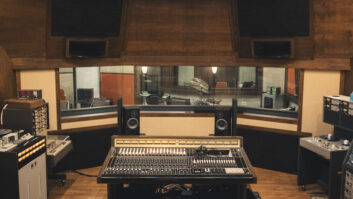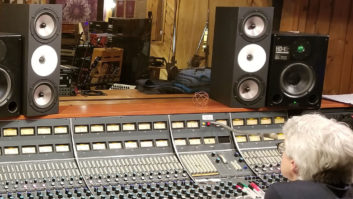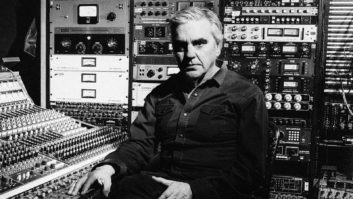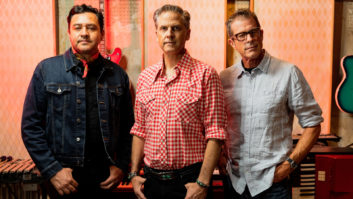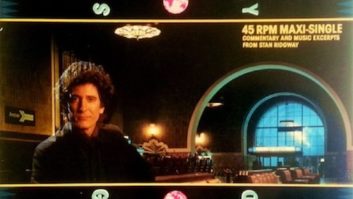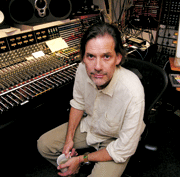
Tchad Blake in the Sound Factory’s Studio B control room, hunkered down at the API console
Tchad Blake, one of music’s most inventive engineers, moved from Los Angeles to England four years ago. Since then, he has been based in a tiny village near Peter Gabriel’s Real World Studios, where he does most of his work in the Big Room. His first major project there was mixing Gabriel’s Up album, which took three months to complete. In addition, he’s been taking on a variety of projects, sometimes as producer and engineer. A few of the artists he has worked with include Phish, progressive jazz group the Bad Plus (whose album, Give, earned Blake a well-deserved Grammy nomination this year in the Best Engineered Album category), Swedish artist Stina Nordenstam, Gomez, Sia, Paul Kelly, Sivert Hoyem, Brendon Benson and Travis.
Blake’s first big hit was Los Lobos’ “La Bamba” with producer Mitchell Froom. He has worked a lot with Froom through the years, and engineered great albums for Los Lobos, Richard Thompson, Suzanne Vega, Tom Waits and Crowded House, to name a few. As engineer and co-producer, one of his best is the Finn Brothers’ Suffer Never. He has also done memorable work with Sheryl Crow, Soul Coughing and Ron Sexsmith.
Blake is a strong-willed engineer who knows no rules — he uses what is available, whether it is new technology or old, and he is known for creative sonics. We met for this interview at L.A.’s Sound Factory, where he was working with Bonnie Raitt on her new album. Next, he’s co-producing an album with Tracy Chapman, recording in San Francisco and mixing in L.A.
What’s your home life like now?
I live in a little cottage that was built 400 years ago, and it’s on a hill just above a very old village. There are no traffic lights, no street lights, no TV antennas. It’s a pretty good little place.
Has this lifestyle change affected your emotional and mental well-being?
Yes, but I wouldn’t have been able to tell you for sure if you had asked me over there, but coming back to L.A., I really find the change. I spent my whole life saying I could never live anywhere else, I loved the city, but I am very happy to have made the change. It’s so good.
How about staying in touch with the music industry?
Well, I think I left at a good time because the music industry, at least on my side of it, has gotten a little bit depressed. I’m really fortunate — I haven’t stopped working, and I know people who have. I don’t know how I have been able to do it, but I think I got some lucky breaks with gigs when I moved. I got a few long-term gigs, including working on Peter Gabriel’s record. I also think that being someone new in Europe created interest in my work.
Do you do all of your work at Real World?
Yes, in the Big Room. I love it, almost as much as this- — Studio B at Sound Factory in L.A. — which is the best-sounding room I’ve ever worked in.
What changes have you made with technology? Are you all Pro Tools now?
No, for instance, this session with Bonnie Raitt was started on tape and I’ll transfer to Pro Tools. Most of the material I get for mixing comes in on Pro Tools. But everything I’ve recorded, like two albums with the Bad Plus, has all been tape — no Pro Tools at all. We’re going to start a third album in April, all on tape.
What other projects have you worked on?
I mixed Stina Nordenstam’s new record. She’s from Sweden and is an amazing writer who sings in English. Very dark subject matter, but she has a beautiful outlook with her music. I love that contrast.
You are well known for having some very odd accessories — your Indian P.A. systems and stomp boxes. Do you still have that arsenal of tools?
Yes, I still have all of it, but most has been in storage until recently. Now I have some good workspaces and I am building a little Pro Tools studio for myself, with all my gear out and ready. It’s because many of the musicians I want to work with can’t really afford Real World. The studio business has really changed, and I am fortunate to be able to work with artists such as Bonnie, who can afford a traditional studio. But by having my own little studio, I will also be able to work with a wide range of musicians, and I can stay in my village and watch my kids grow up.
What percentage of your work is as a producer, as opposed to being an engineer or a mixer?
Producing is a lower percentage, but since I’ve been in England…get this, I have people calling me up to produce singles! I had to say, “Okay, are you sure you have the right Tchad Blake?” I’m not known for my “radio-friendly” sound. But they are calling me to produce singles, maybe because they finished their record and want me to take things a little further. It’s weird, but I am happy to give it a try. I am also being asked to mix singles — who would have thought I would be doing that? When I was here [in L.A.], they would probably take it to Bob Clearmountain to mix which was fine, because I love Bob’s work.
It’s an odd thing that over in England I have more offers as a producer, though I am a reluctant one. I’m really an engineer/producer, not a composer/producer. I have to be very careful, because if the artist needs a lot of work on songs from a compositional perspective, I have shortcomings. I like working with artists who have strengths in arrangements and are musically adept. I think I am good at contributing atmosphere and helping them flesh things out. That’s why it was so good working with Mitchell Froom. We had our little areas of expertise. I miss working with Mitchell immensely. Solo producing is not my favorite job. Some of the material I get asked to mix isn’t up to scratch and I think it would be easier to produce than mix, but I am always wrong. Producing is such a huge commitment, so I really try to pick the work I will produce.
Are people flying in from faraway places to work with you?
Yes, for instance, I did a record with Apartment 26, a rock band. They are actually from England, but they were signed in America, where they were living. I produced the record and Chris Lord-Alge mixed it. It turned out really well, but the record company fell apart and I don’t know what came of it.
What is your opinion of the digital state-of-the-art gear today? What’s new and good?
I don’t know. I’m just getting into it. I did a Phish record in January 2004, and up until then, I knew very little about Pro Tools. I always had an assistant or worked with my wife, Jacquie, who is the Pro Tools brain of the family. I don’t like to look at music. It really bugs me to look at a screen, but it’s impossible to ignore now.
The HD system sounds great, and I am hearing mixes that really just blow me away. It makes me want to go there and I have started to learn it. Three weeks ago, I bought a [Digidesign] 002 to start playing around. With the Phish record, I learned how to do the simple things because I didn’t like sitting over someone’s shoulder and telling them what to do. You just want to do it yourself.
What about plug-ins vs. dedicated outboard gear?
There are some great plug-ins. I have a little story to tell about working with Bonnie. She played a guitar part and she wanted it to sound weird. I said, “Great, here I go.” I got up and rummaged through one of the cabinets here at the studio and found some of my old tuned metal pipes, got a trash can, a little amplifier and a couple of microphones. I was going to start my process of getting that “weird” sound. I was out of the control room for a very short time and when I got back, my assistant, Scott Wiley, who is working the Pro Tools and is a great engineer, had used an Echo Farm plug-in, plus a filter on the guitar. I was ready to set up to record and he asked me to listen. It sounded great. I [thought] maybe I should take a break and check on the kids, you know?
Do you have any favorite plug-ins?
I love lo-fi. The [Tech 21] Sans Amp plug-in sounds great. All of the Moog plug-ins sound good to me. They’re not the same as the originals, but somehow they’ve made them new again. That’s what I love. I am finding that some of the plug-in compressors are very transparent. Most of the time, I want coloration and if somebody tells me a piece of gear is really “flat,” I usually don’t want it. Speakers, microphones — I don’t care what it is. Flat, to me, is not good. I want color, I might want boost on the bottom for some applications or I might want the top to drop off in a certain way. Having said that, there are times you need a compressor that’s invisible. And some of the plug-ins are invisible, as compared to going through an 1176 or an LA-3A. The 1176 plug-in has less character than the real thing, but there is a use for it.
When people make re-issues, the first thing they do is make it less noisy. “Hey, we’ve got this fuzz box that is exactly like the ones Hendrix used, but we’ve gotten rid of the noise!” So what did they do to get that? Anyway, there are changes, and I like it all. I’ve always liked the process — I don’t care what the equipment is. I don’t care if it’s a shitty piece of solid-state gear or tube gear. It’s all good, and they all do different things and there is a use for all of it. I’m going be a Pro Tools guy in 2005!
Any records you’ve recently heard that have blown you away?
The first N.E.R.D. record kills me. Missy Elliott — all of her records sound great; nothing better sonically. Eminem records are great. Dr. Dre, 50 Cent. For me, all the stuff that was really cool about the ’60s was the experimentation and the mind-set of playing around in the studio. It’s a fantasyland, and you have the freedom to try whatever you want. That’s what is in hip hop now. For me, it’s not happening in pop music or rock music, though there are always exceptions. There is just more experimentation in the hip hop world.
Have you recorded any hip hop?
No, it’s not something that I would normally get asked to do, but I would love to. And listen to Timbaland — the experimentation going on with that producer absolutely blows my mind. There are great mixers and many great-sounding records being made these days. I’m not a Britney Spears fan, but her last record is sonically stunning. Serban Ghenea in Virginia did some of those mixes, and also Niklas Flyckt, who works out of Sweden. That song “Toxic” has absolutely brilliant mixing and production.
On a completely different note, I’d like to mention another great record: Nigel Kennedy with Kroke, East Meets East. I can’t describe the record, but it is so beautifully and flawlessly done. It’s a kind of a klezmer classical music. I wish I had recorded it — it is one of the most beautiful records I’ve ever heard in my life.
With the transformation of the recording industry and the demise of so many studios, have you seen that in England?
Yes, that’s why I am getting into my own studio, and I never before wanted to have a studio of my own. But because of the changes, people are listening differently. It took getting an iPod to figure out what’s different now. I’m an old dog who just listens to albums, but the guys from Phish gave me an iPod and I started getting into it. I loaded songs in, put it on Shuffle and went out riding my bicycle. All of a sudden, I discovered it was really cool. I’m digging hearing these weird segues between different kinds of music. Now I get it — it’s really fun. And it’s not about albums, it’s about tunes.
The album genre is a lot of fun, but it has become a bit of a dinosaur. I think the whole Internet thing is going through growing pains, but it’s going to be very good for the music business. People will figure out how to keep the rewards of their production and learn out how to make a living with it, because the artist has a job like anyone else. People have to make a living, and when the piracy problems are resolved, it will grow and grow and be bigger than ever. More people will have access to the music, more kinds of people will have access, artists with smaller audiences will be able to sell their work and make a decent living. It’s brilliant. Soon, it’s going to crack wide open and there will be a tornado of new creativity. It’s gonna blow our minds.


